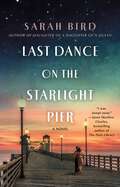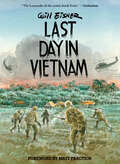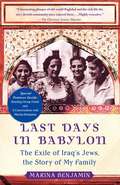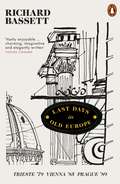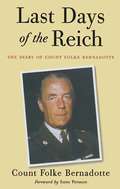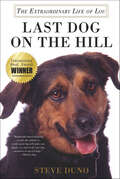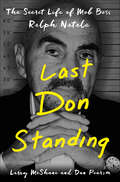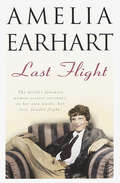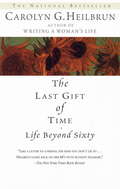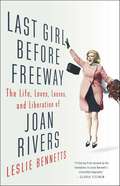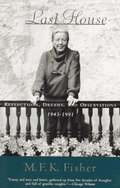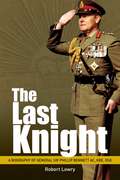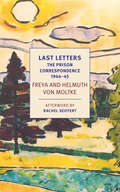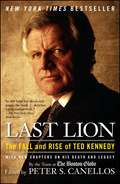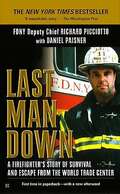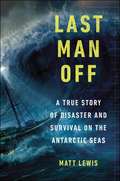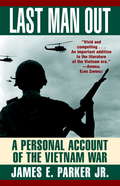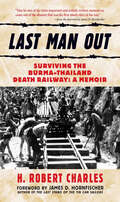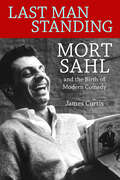- Table View
- List View
Last Charge of the Rough Rider: Theodore Roosevelt's Final Days
by William Hazelgrove William Elliott HazelgroveThere have been many books on Theodore Roosevelt, but there are none that solely focus on the last years of his life. Racked by rheumatism, a ticking embolism, pathogens in his blood, a bad leg from an accident, and a bullet in his chest from an assassination attempt, in the last two years of his life from April 1917 to January 6, 1919, he went from the great disappointment of being denied his own regiment in World War I, leading a suicide mission of Rough Riders against the Germans, to the devastating news that his son Quentin had been shot down and killed over France. Suffering from grief and guilt, marginalized by world events, the great glow that had been his life was now but a dimming lantern. But TR&’s final years were productive ones as well: he churned out several &“instant&” books that promoted U.S. entry into the Great War, and he was making plans for another run at the Presidency in 1920 at the time of his death. Indeed, his political influence was so great that his opposition to the policies of Woodrow Wilson helped the Republican Party take back the Congress in 1918. However, as William Hazelgrove points out in this book, it was Roosevelt&’s quest for the &“vigorous life&” that, ironically, may have led to his early demise at the age of sixty. "The Old Lion is dead,&” TR&’s son Archie cabled his brother on January 6, 1919, and so, too, ended a historic era in American life and politics.
Last Dance on the Starlight Pier: A Novel
by Sarah BirdSet during the Great Depression, Sarah Bird's Last Dance on the Starlight Pier is a novel about one woman—and a nation—struggling to be reborn from the ashes.July 3. 1932. Shivering and in shock, Evie Grace Devlin watches the Starlite Palace burn into the sea and wonders how she became a person who would cause a man to kill himself. She’d come to Galveston to escape a dark past in vaudeville and become a good person, a nurse. When that dream is cruelly thwarted, Evie is swept into the alien world of dance marathons. All that she has been denied—a family, a purpose, even love—waits for her there in the place she dreads most: the spotlight.Last Dance on the Starlight Pier is a sweeping novel that brings to spectacular life the enthralling worlds of both dance marathons and the family-run empire of vice that was Galveston in the Thirties. Unforgettable characters tell a story that is still deeply resonant today as America learns what Evie learns, that there truly isn’t anything this country can’t do when we do it together. That indomitable spirit powers a story that is a testament to the deep well of resilience in us all that allows us to not only survive the hardest of hard times, but to find joy, friends, and even family, in them.
Last Day in Vietnam (2nd edition)
by Will EisnerReleased to coincide with Will Eisner Week—the annual celebration of Eisner’s life and work—Last Day in Vietnam is now available in a handsome new hardcover edition!Last Day in Vietnam recounts the artist’s own experiences with soldiers engaged not only in the daily hostilities of war but also in larger, more personal combat. Some of the stories in this novel are comical, some heartrending, some frightening, yet all display the incredible insight into humanity characteristic of Eisner’s entire oeuvre. Printed with special sepia ink and in hardcover for the first time, this new edition gives this modern classic the literary presentation it deserves!
Last Days in Babylon: The History of a Family, The Story of a Nation
by Marina BenjaminMarina Benjamin grew up in London feeling estranged from her family's exotic Middle Eastern ways. She refused to speak the Arabic her mother and grandmother spoke at home. She rejected the peculiar food they ate in favor of hamburgers and beer. But when Benjamin had her own child a few years ago, she realized that she was losing her link to the past. In Last Days in Babylon, Benjamin delves into the story of her family's life among the Jews of Iraq in the first half of the twentieth century. When Iraq gained independence in 1932, Jews were the largest and most prosperous ethnic group in Baghdad. They dominated trade and finance, hobnobbed with Iraqi dignitaries, and lived in grandiose villas on the banks of the Tigris. Just twenty years later the community had been utterly ravaged, its members effectively expelled from the country by a hostile Iraqi government. Benjamin's grandmother Regina Sehayek lived through it all. Born in 1905, when Baghdad was still under Ottoman control, her childhood was a virtual idyll. This privileged existence was barely touched when the British marched into Iraq. But with the rise of Arab nationalism and the first stirrings of anti-Zionism, Regina, then a young mother, began to have dark premonitions of what was to come. By the time Iraq was galvanized by war, revolution, and regicide, Regina was already gone, her hair-raising escape a tragic exodus from a land she loved -- and a permanent departure from the husband whose gentle guiding hand had made her the woman she was. Benjamin's keen ear and fluid writing bring to life Regina's Baghdad, both good and bad. More than a stirring story of survival, Last Days in Babylon is a bittersweet portrait of Old World Baghdad and its colorful Jewish community, whose roots predate the birth of Islam by a thousand years and whose culture did much to make Iraq the peaceful desert paradise that has since become a distant memory. In 2004 Benjamin visited Baghdad for the first time, searching for the remains of its once vital Jewish community. What she discovered will haunt anyone who seeks to understand a country that continues to command the world's attention, just as it did when Regina Sehayek proudly walked through Baghdad's streets. By turns moving and funny, Last Days in Babylon is an adventure story, a riveting history, and a timely reminder that behind today's headlines are real people whose lives are caught -- too often tragically -- in the crossfire of misunderstanding, age-old prejudice, and geopolitical ambition.
Last Days in Old Europe: Trieste '79, Vienna '85, Prague '89
by Richard BassettSelected as a Book of the Year in the TLS and SpectatorThe final decade of the Cold War, through the eyes of a laconic and elegant observerIn 1979 Richard Bassett set out on a series of adventures and encounters in central Europe which allowed him to savour the last embers of the cosmopolitan old Hapsburg lands and gave him a ringside seat at the fall of another ancien regime, that of communist rule. From Trieste to Prague and Vienna to Warsaw, fading aristocrats, charming gangsters, fractious diplomats and glamorous informants provided him with an unexpected counterpoint to the austerities of life along the Iron Curtain, first as a professional musician and then as a foreign correspondent.The book shows us familiar events and places from unusual vantage points: dilapidated mansions and boarding-houses, train carriages and cafes, where the game of espionage between east and west is often set. There are unexpected encounters with Shirley Temple, Fitzroy Maclean, Lech Walesa and the last Empress of Austria. Bassett finds himself at the funeral of King Nicola of Montenegro in Cetinje, plays bridge with the last man alive to have been decorated by the Austrian Emperor Franz-Josef and watches the KGB representative in Prague bestowing the last rites on the Soviet empire in Europe.Music and painting, architecture and landscape, food and wine, friendship and history run through the book. The author is lucky, observant and leans romantically towards the values of an older age. He brilliantly conjures the time, the people he meets, and Mitteleuropa in one of the pivotal decades of its history.
Last Days of Theresienstadt (George L. Mosse Series in Modern European Cultural and Intellectual History)
by Eva Noack-MosseIn February of 1945, during the final months of the Third Reich, Eva Noack-Mosse was deported to the Nazi concentration camp of Theresienstadt. A trained journalist and expert typist, she was put to work in the Central Evidence office of the camp, compiling endless lists—inmates arriving, inmates deported, possessions confiscated from inmates, and all the obsessive details required by the SS. With access to camp records, she also recorded statistics and her own observations in a secret diary. Noack-Mosse's aim in documenting the horrors of daily life within Theresienstadt was to ensure that such a catastrophe could never be repeated. She also gathered from surviving inmates information about earlier events within the walled fortress, witnessed the defeat and departure of the Nazis, saw the arrival of the International Red Cross and the Soviet Army takeover of the camp and town, assisted in administration of the camp's closure, and aided displaced persons in discovering the fates of their family and friends. After the war ended, and she returned home, Noack-Mosse cross-referenced her data with that of others to provide evidence of Nazi crimes. At least 35,000 people died at Theresienstadt and another 90,000 were sent on to death camps.
Last Days of the Reich: The Diary of Count Folke Bernadotte
by Folke BernadotteCount Folke Bernadotte was one of those rare figures in war ' a man trusted by both sides alike. Shortly before the war ended, Bernadotte was the leader of a rescue operation to transfer western European inmates to Swedish hospitals in the so-called 'White Buses'. This work through the Swedish Red Cross involved mercy missions to Germany and it was through this link that Bernadotte came into touch with prominent Nazi leaders in the 1940s. During the last months of the war, Bernadotte was introduced to Heinrich Himmler ' one of the most sinister men of the Third Reich. Bernadotte was asked by Himmler to approach the Allies with the proposal of a complete surrender to Britain and the US ' providing Germany could continue to fight the Soviet Union. The offer was passed to Winston Churchill and Harry Truman, but rejected. The course of these negotiations is narrated in this book with a simple, compelling clarity and thrilling immediacy. This new edition of Bernadotte's memoir includes a Preface by his two sons, and an Introduction by a leading Swedish author discussing Count Bernadotte's wartime record and his post-war assassination.
Last Dog on the Hill: The Extraordinary Life of Lou
by Steve DunoThe moving story of the author's adopted Rottweiler mix, Lou, a free-thinking heroic dog who changed his life forever Born of guard dogs on a secret marijuana farm in Mendicino County, Lou truly was one dog in a million. On the winter day that the ailing, tick-infested feral pup was rescued by Steve Duno, neither dog nor man had a clue as to what they were getting into, or where the relationship would lead. Last Dog on the Hill tells the story of an indigent young Rottweiler mix who, after abandoning his pack and the hills of his birth, went on to change the lives of hundreds of people and dogs, including the author's, whose career as a behaviorist and writer was made possible through Lou's extraordinary intelligence and heart. Lou won the respect of gang members, foiled an armed robbery, caught a rapist, fought coyotes and kidnappers, comforted elderly war veterans and Alzheimer patients in their final days, taught ASL to kids, learned scores of unique behaviors and tricks, amassed a vocabulary of nearly 200 words, helped rehabilitate hundreds of aggressive dogs and saved them from euthanasia. He was also a clown, consummate performer and Steve's best friend for sixteen years. His story will make readers laugh and cry in equal measures.
Last Don Standing: The Secret Life of Mob Boss Ralph Natale
by Dan Pearson Larry McShaneAs the last Don of the Philadelphia mob, Ralph Natale, the first-ever mob boss to turn state’s evidence, provides an insider’s perspective on the mafia. Natale’s reign atop the Philadelphia and New Jersey underworlds brought the region’s mafia back to prominence in the 1990s. Smart, savvy, and articulate, Natale came up in the mob and saw first-hand as it hatched its plan to control Atlantic City’s casino unions. Later on, after spending 16 years in prison, he reclaimed the family as his own after a bloody mob war that left bodies scattered across South Philly. He forged connections around the country, invigorated the family with more allies than it had in two decades, and achieved a status within the mob never seen before or since until he was betrayed by his men and decided to testify against them in a stunning turn of events.Using dozens of hours of interviews with Natale along with research and interviews with FBI agents, this book delivers revelatory insights into seminal events in American mob history, including:- The truth about Jimmy Hoffa’s disappearance- The murder of Jewish mob icon Bugsy Siegel - The identity of the man who created modern-day Las VegasWith the full cooperation of Natale, New York Daily News reporter Larry McShane and producer Dan Pearson uncover the deadly reign of the last great mob boss of Philadelphia, a tale that covers a half-century of mob lore—and gore.
Last Drink to LA: Confessions Of An Aa Survivor
by John SutherlandThirty-one years ago John Sutherland nearly lost everything to drink. It was time to sober up. Or die. Last Drink To LA is part reportage, part confession - not a temperance tale (told to terrify, inform and instruct), not what AA calls a "drunkalog", but a moving and thought-provoking meditation - some thinking about drinking.
Last Drink to LA: Confessions Of An Aa Survivor
by John SutherlandThirty-one years ago John Sutherland nearly lost everything to drink. It was time to sober up. Or die. Last Drink To LA is part reportage, part confession - not a temperance tale (told to terrify, inform and instruct), not what AA calls a "drunkalog", but a moving and thought-provoking meditation - some thinking about drinking.
Last Explorer: Hubert Wilkins, Hero of the Golden Age of Polar Exploration
by Simon NashtIn the tradition of The Ice Master and Endurance, here is the incredible story of the first truly modern explorer, whose death-defying adventures and uncommon modesty make this book itself an extraordinary discovery. Hubert Wilkins was the most successful explorer in history-no one saw with his own eyes more undiscovered land and sea. Largely self-taught, Wilkins became a celebrated newsreel cameraman in the early 1900s, as well as a reporter, pilot, spy, war hero, scientist, and adventurer, capturing in his lens war and famine, cheating death repeatedly, meeting world leaders like Lenin and Stalin, and circling the globe on a zeppelin. Apprenticing with the greats of polar exploration, including Shackleton in the Antarctic, Wilkins recognized the importance of new technologies such as the airplane and submarine. He helped map the Canadian Arctic and plumbed the ocean depths from the icecap. A pioneer in the truest sense of the word, he became the first man to fly across the North Pole, which won him a knighthood; the first to fly to the Antarctic and discover land there by airplane; and the first to take a submarine under the Arctic ice. Grasping the link between the poles and changing global weather, Wilkins was a visionary in weather forecasting and the study of global warming. A true hero of the earth, he changed the way we look at our world.
Last Flight
by Amelia EarhartAmelia Earhart was twice the first woman to cross the Atlantic by air: initially in 1928 as a passenger just a year after Lindbergh's pioneering flight and then in 1932 flying solo. Like her contemporaries Amy Johnson and Beryl Markham she was featured in all the fashionable magazines of the day as a symbol of the new independent woman. The list of records Amelia established reads like a catalogue of aviation history and includes the first flights from Hawaii to California and from California to Mexico...
Last Gift of Time
by Carolyn G. HeilbrunWhen she was young, distinguished author and critic Carolyn Heilbrun solemnly vowed to end her life when she turned seventy. But on the advent of that fateful birthday, she realized that her golden years had been full of unforeseen pleasures. Now, the astute and ever-insightful Heilbrun muses on the emotional and intellectual insights that brought her "to choose each day for now, to live." There are reflections on her new house and her sturdy, comfortable marriage; sweet solitude and the pleasures of sex at an advanced age; the fascination with e-mail and the joy of discovering unexpected friends. Even the encroachments of loss, pain, and sadness that come with age cannot spoil Heilbrun's moveable feast. They are merely the price of bountiful living. (From the Trade Paperback edition.)
Last Girl Before Freeway: The Life, Loves, Losses, and Liberation of Joan Rivers
by Leslie BennettsThe definitive book about Joan Rivers' tumultuous, victorious, tragic, hilarious, and fascinating life.Joan Rivers was more than a legendary comedian; she was an icon and a role model to millions, a fearless pioneer who left a legacy of expanded opportunity when she died in 2014. Her life was a dramatic roller-coaster of triumphant highs and devastating lows: the suicide of her husband, her feud with Johnny Carson, her estrangement from her daughter, her many plastic surgeries, her ferocious ambition and her massive insecurities. But Rivers' career was also hugely significant in American cultural history, breaking down barriers for her gender and pushing the boundaries of truth-telling for women in public life. A juicy, intimate biography of one of the greatest comedians ever-a performer whose sixty year career was borne, simply, out of a desire to make people laugh so she could feel loved-LAST GIRL BEFORE FREEWAY delves into the inner workings of a woman who both reflected and redefined the world around her.
Last House: Reflections, Dreams, and Observations 1943-1991
by M. F. K. FisherAlong with To Begin Again and Stay Me, Oh Comfort Me, this anthology was the last project M.F.K. Fisher worked on before her death in 1992. Last House presents a frank, wry, and revealing portrait of Fisher's life, her loves, and herself.
Last Knight: A Biography of General Sir Phillip Bennett AC, KBE, DSO (Big Sky Publishing Ser.)
by Robert LowryGeneral Sir Phillip Bennett is a good example of what makes a great leader. With a good combination of innate personal qualities, education, broad experience and the hardening that comes with survival on the battlefield he prospered. As a young officer he survived the first and most perilous year of the Korean War, including the Battle of Kapyong.
Last Letters: The Prison Correspondence between Helmuth James and Freya von Moltke, 1944-45
by Rachel SeiffertAvailable for the first time in English, a moving prison correspondence between a husband and wife who resisted the Nazis.Tegel prison, Berlin, in the fall of 1944. Helmuth James von Moltke is awaiting trial for his leading role in the Kreisau Circle, one of the most important German resistance groups against the Nazis. By a near miracle, the prison chaplain at Tegel is Harald Poelchau, a friend and co-conspirator of Helmuth and his wife, Freya. From Helmuth’s arrival at Tegel in late September 1944 until the day of his execution by the Nazis on January 23, 1945, Poelchau would carry Helmuth’s and Freya’s letters in and out of prison daily, risking his own life. Freya would safeguard these letters for the rest of her long life, much of it spent in Norwich, VT, from 1960 until her death in 2010.Last Letters is a profoundly personal record of the couple’s love, faith, and courage in the face of fascism. Written during the final months of World War II, the correspondence is at once a collection of love letters written in extremis and a historical document of the first order. Published to great acclaim in Germany, this volume now makes this deeply moving correspondence available for the first time in English.
Last Lion: The Fall and Rise of Ted Kennedy
by Peter S. CanellosThe comprehensive New York Times bestselling biography of Senator Ted Kennedy dives deeply into his political career, his shocking downfall, and his redemption from disappointing member of a grand dynasty to respected sage in the Senate.No figure in American public life had such great expectations thrust upon him and fallen short of them so quickly. But Ted Kennedy, the gregarious, pudgy, and least academically successful of the Kennedy boys, became the most powerful senator for over forty years and the nation&’s keeper of traditional liberalism. As Peter S. Canellos and his team of reporters from The Boston Globe show in this intimate biography, Ted witnessed greater tragedy and suffered greater pressure than his siblings. He inherited a generation&’s dreams and was expected to help confront his nation&’s problems in order to build a fairer society. But political rivals turned his all-too-human failings into a condemnation of his liberal politics. As the presidency eluded his grasp, Kennedy was finally free to become his own man. He transformed himself into a symbol of wisdom and perseverance. Perceptive and carefully reported, drawing from candid interviews with the Kennedy family, Last Lion captures magnificently the life, historic achievements, and personal redemption of Ted Kennedy, and offers a fresh assessment of his enduring legacy.
Last Man Down: A Firefighter's Story of Survival and Escape from the World Trade Center
by Daniel Paisner Richard PicciottoOn September 11, 2001, FDNY Battalion Chief Richard "Pitch" Picciotto answered the call heard around the world. In minutes he was at Ground Zero of the worst terrorist attack on American soil, as the Twin Towers of the World Trade Center began to burn--and then to buckle. A veteran of the 1993 bombing of the World Trade Center, Picciotto was eerily familiar with the inside of the North Tower. And it was there that he concentrated his rescue efforts. It was in its smoky stairwells where he heard and felt the South Tower collapse. Where he made the call for firemen and rescue workers to evacuate, while he stayed behind with a skeleton team of men to help evacuate a group of disabled and infirm civilians. And it was in the rubble of the North Tower where Picciotto found himself buried--for more than four hours after the building's collapse. This is the harrowing true story of a true American hero, a man who thought nothing of himself--and gave nearly everything for others during one of New York City's--and the country's--darkest hours.
Last Man Off
by Matt Lewis"A sinister version of The Perfect Storm . . . Thrilling." --Sunday Times (UK) For readers of The Perfect Storm, Between a Rock and a Hard Place, and Into the Wild There's nothing that armchair adventure lovers relish more than a gripping true story of disaster and heroism, and Last Man Off delivers all that against a breathtaking backdrop of icebergs and killer whales. On June 6, 1998, twenty-three-year-old Matt Lewis had just started his dream job as a scientific observer aboard a deep-sea fishing boat in the waters off Antarctica. As the crew haul in the line for the day, a storm begins to brew. When the captain vanishes and they are forced to abandon ship, Lewis leads the escape onto three life rafts, where the battle for survival begins.From the Trade Paperback edition.
Last Man Out
by Melissa Fay GreeneThe deepest coal mine in North America was notoriously unpredictable. One late October evening in 1958, it "bumped" - its rock floors heaving up and smashing into rock ceilings. A few miners staggered out, most of the 174 on shift did not.Nineteen men were trapped, plunged into darkness, hunger, thirst, and hallucination. As days and nights passed, the survivors began to hope for death by gas rather than from thirst. Above ground, journalists and families stood in despairing vigil, as rescuers brought out scores of the dead. The hope of finding life undergound faded and families made funeral preparations.Then, a miracle: Rescuers stumbled across a broken pipe leading to a cave of survivors, then a second group was discovered.A media circus followed. Ed Sullivan, then the state of Georgia, invited survivors to visit. Publicity, politics, and segregation sorted the men differently than they had ordered themselves. Underground, the one black survivor nursed a dying man; in Atlanta, Governor Marvin Griffin said: "I will not shake hands with a Negro."If every great writer has one tale of peril, heroism, and survival, Last Man Out is Melissa Fay Greene's. Using long-lost stories and interviews with survivors, Greene has reconstructed the drama of their struggle to stay alive
Last Man Out: A Personal Account of the Vietnam War
by James E. Parker Jr."I WAS AMONG THE FIRST MEN IN, AND I WAS THE LAST MAN OUT. " In Vietnam, at both the start and finish of the conflict, 2d Lt. James E. Parker Jr. saw the war as few men did. Now, with uncommon insight and raw honesty, he captures the stark realities of jungle combat, heavy casualties, and heroic sacrifice. From the tight confines of a VC-occupied Cu Chi tunnel to bloody firefights in areas that hardcore VC and NVA vets had controlled for decades, Parker relives the rain, the heat, the horror, the pain--and the anguish of kneeling beside a buddy whose blood turnd the soil black as he lays dying. Vietnam exacted a very high price. Parker pays tribute to the men who paid it.
Last Man Out: Surviving the Burma-Thailand Death Railway: A Memoir
by H. Robert CharlesAn American Marine recounts his ordeal as a World War II POW forced by the Japanese to build the railway immortalized in The Bridge on the River Kwai.From June 1942 to October 1943, more than 100,000 Allied POWs who had been forced into slave labor by the Japanese died building the infamous Burma-Thailand Death Railway, an undertaking immortalized in the film The Bridge on the River Kwai. One of the few who survived was American Marine H. Robert Charles, who describes the ordeal in vivid and harrowing detail in Last Man Out. The story mixes the unimaginable brutality of the camps with the inspiring courage of the men, such as a Dutch Colonial Army doctor whose skill and knowledge of the medicinal value of wild jungle herbs saved the lives of hundreds of his fellow POWs, including the author.Praise for Last Man Out“A remarkable story, long overdue, of the treatment of POW’s captured by Japan.” —Arthur L. Maher, USN, Senior officer to survive sinking of the USS Houston, POW of the Japanese in World War II“In World War II, to move materials and troops from Japan to Burma by avoiding the perilous sea route around the Malay Peninsula, the Japanese military built a railroad through the jungles of Thailand and Burma at great human cost to its prisoner laborers. Last Man Out is an effective addition to the history of this tragedy.” —Library Journal
Last Man Standing: Mort Sahl and the Birth of Modern Comedy
by James CurtisA Times Literary Supplement 2017 Book of the YearOn December 22, 1953, Mort Sahl (1927–2021) took the stage at San Francisco's hungry i and changed comedy forever. Before him, standup was about everything but hard news and politics. In his wake, a new generation of smart comics emerged—Shelley Berman, Mike Nichols and Elaine May, Lenny Bruce, Bob Newhart, Dick Gregory, Woody Allen, and the Smothers Brothers, among others. He opened up jazz-inflected satire to a loose network of clubs, cut the first modern comedy album, and appeared on the cover of Time surrounded by caricatures of some of his frequent targets such as Dwight Eisenhower, Richard Nixon, Adlai Stevenson, and John F. Kennedy. Through the extraordinary details of Sahl's life, author James Curtis deftly illustrates why Sahl was dubbed by Steve Allen as “the only real political philosopher we have in modern comedy.”Sahl came on the scene the same year Eisenhower and Nixon entered the White House, the year Playboy first hit the nation's newsstands. Clad in an open collar and pullover sweater, he adopted the persona of a graduate student ruminating on current events. “It was like nothing I'd ever seen,” said Woody Allen, “and I've never seen anything like it after.” Sahl was billed, variously, as the Nation's Conscience, America's Only Working Philosopher, and, most tellingly, the Next President of the United States. Yet he was also a satirist so savage the editors of Time once dubbed him “Will Rogers with fangs.”Here, for the first time, is the whole story of Mort Sahl, America's iconoclastic father of modern standup comedy. Written with Sahl's full cooperation and the participation of many of his friends and contemporaries, it delves deeply into the influences that shaped him, the heady times in which he soared, and the depths to which he fell during the turbulent sixties when he took on the Warren Commission and nearly paid for it with his career.

